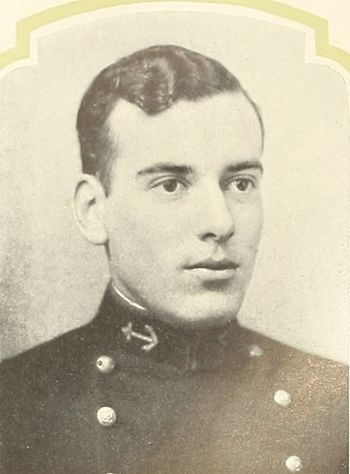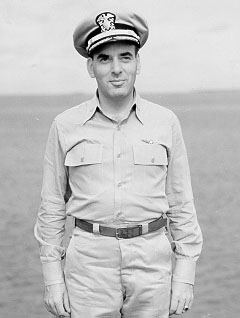JAMES K. AVERILL, CDR, USN
James Averill '27
Lucky Bag
From the 1927 Lucky Bag:
James Kent Averill
Champlain, New York
"Jimmie" "Wife"
KENT emigrated from "the best little old place in the world" to Severn School, where he prepped for two years, and from there he continued his journey to the Academy, filled with an ambition and cheerfulness that have never deserted him. Champlain and his "uke" are his only two weaknesses. When he starts on either of them you have to stop and listen. Oh, yes, one more weakness, Buffalo, New York.
When Jimmie entered the Academy he had forgotten to bring one important article along with him—a book in which to write the names of his spoons. Can anyone look into those brown eyes without giving him another thought? Can anyone talk to him without wishing to add him to their list of friends? The "no's" have it. Five years have been the proof of it. Plebe year, Wife tried his luck on the mat, and became so interested in it that the Ac Department was neglected. One Christmas tree was enough though, and thereafter the Acs never scored another victory.
Did you ask about femmes? Doesn't that permanent wave speak for itself? Jimmie's a mean hombre when it comes to dancing. "Girls, I'm two hours overtime on hop liberty now, and I will have to say good night."
A true friend, a hard worker, dependable, cheerful, that's our Jimmie, and we are sure that he will go a long way up the ladder of success.
Wrestling: A Squad (3, 2) Plebe Team (4) Navy Numerals (4).

James Kent Averill
Champlain, New York
"Jimmie" "Wife"
KENT emigrated from "the best little old place in the world" to Severn School, where he prepped for two years, and from there he continued his journey to the Academy, filled with an ambition and cheerfulness that have never deserted him. Champlain and his "uke" are his only two weaknesses. When he starts on either of them you have to stop and listen. Oh, yes, one more weakness, Buffalo, New York.
When Jimmie entered the Academy he had forgotten to bring one important article along with him—a book in which to write the names of his spoons. Can anyone look into those brown eyes without giving him another thought? Can anyone talk to him without wishing to add him to their list of friends? The "no's" have it. Five years have been the proof of it. Plebe year, Wife tried his luck on the mat, and became so interested in it that the Ac Department was neglected. One Christmas tree was enough though, and thereafter the Acs never scored another victory.
Did you ask about femmes? Doesn't that permanent wave speak for itself? Jimmie's a mean hombre when it comes to dancing. "Girls, I'm two hours overtime on hop liberty now, and I will have to say good night."
A true friend, a hard worker, dependable, cheerful, that's our Jimmie, and we are sure that he will go a long way up the ladder of success.
Wrestling: A Squad (3, 2) Plebe Team (4) Navy Numerals (4).
Loss
James was lost on March 26, 1944 when the aircraft he was aboard crashed immediately after takeoff from USS Lexington (CV 16). He was Chief of Staff for Carrier Division 11 at the time of his loss, and was returning to the flagship, USS Yorktown (CV 10).
From naval aviation historian Richard Leonard via email on April 12, 2018:
Averill was killed in a crash taking off from USS Lexington. My list has him "ComTG 58.4 (CoS) KIFA VT-5 TBF crash T/O from CV-16 BNR."
He was in a VT-5 (USS Yorktown) TBF in which he had flown over to Lexington from Yorktown.
War Diary USS Yorktown CV-10
March 26, 1944 – Sunday
Steaming as before in task group 58.3 in cruising disposition 5R-1. At 0602 the U.S.S. SUAMICO, U.S.S. ASHTABULA, U.S.S. EICHENBERGER and U.S.S MANNING of task unit 50.15 were sighted. At 0657 the force formed fueling disposition 5-F. The fueling operations continued throughout the morning and afternoon. This ship went alongside the U.S.S. SUAMICO at 0701 and completed receiving fuel and aviation gasoline at 1026. Upon completion of fueling this ship took position in the carrier zigzag line. Upon completion of fueling the task group, cruising disposition 5R-1 was formed, axis 070°(T). During the afternoon, TBF#13, piloted by Lt(jg) Rubner was launched to transport Commander J. K. Averill, USN., Chief of Staff, Comcardiv 11, to the U.S.S. LEXINGTON. This plane crashed on take-off from the U.S.S. LEXINGTON and Commander Averill was killed in the crash or failed to get clear of the plane and drowned. The pilot and radioman were recovered by a destroyer and later returned to this ship. CTF 58 operation plan #4-44 delivered aboard revealed that this task group was a part of a striking force aimed against Japanese-held Palau, Yap, and Woleai Islands.
I have seen it written that Averill's death was so disheartening to RAdm Ginder that it effected his performance as a task group commander and hastened his removal from combat.
Other Information
From the Buffalo Evening News, January 12, 1934, via researcher Kathy Franz:
Buffalo Pilot Tells of Fight with Fog on Hop to Hawaii
Navy Planes Flew Through Night at Altitude of From Three to 6000 Feet Says Lieut. AverillBy Lieut. James K. Averill
Buffalo Pilot of the Navy Seaplane 10-P-6, Copyright, 1934, by the United Press.
HONOLULU, Jan. 12 – We were in the last plane to take off from Paradise Cove, San Francisco bay, Wednesday.
After fighting an adverse wind and an ebb tide, we left the water at 1:45 P. M., P. S.T. As we passed the Golden Gate at 2:25, there were 1700 gallons of gasoline left in the tanks.
The weather was fair as we proceeded out to sea in formation, Lieut. Commander McGinnis in the lead. Shortly thereafter small cloud banks were encountered.
We saw a lightship, but it was not the Farrallones.
Shortly before sunset we reached the U. S. S. Sandpiper (stationed 300 miles from the Golden Gate). We had a northeast tail wind and it gave us an advantage. We were making 85 knots.
It was dark at 6:30, low rifts of fog were encountered at 7:05.
We dove to as low as three feet from the surface of the water, but it was foggy there too, so we went up again.
Fog 6000 Feet Up.
Gradually the fog increased. It had extended up 3500 feet but it increased to 6000 feet. By 7:30 in the evening the fog was a heavy bank.
At that time the second section of the planes, of which ours was a member, split from the first section in which Commander McGinnis was flying.
The 10P4, 10P5 and 10P6 became separated and our ship was flying alone, invisible in the fog and darkness.
We climbed to 2500 feet but the fog didn’t thin. Thereafter, we took a westerly course for 15 minutes, then steadied back on the base course.
At 9 o’clock we sighted the searchlight on the U. S. S. Schenck (stationed 600 miles from the Golden Gate) and we saw the first section ahead of us.
We could not see the other planes of our section, as we joined Commander McGinnis’ section, but no concern was felt. Later we learned that the 10P4 and 10P5 had speeded ahead of us.
Running Away From Sun.
The fog continued until 2:30 o’clock Thursday morning. At 3 o’clock we passed the U. S. S. Breese (900 miles from the Golden Gate).
It was a welcome sight to see the stars for more than five minutes at a time.
At 4:50 o’clock we passed the Whippoorwill (1200 miles from the Golden Gate). At 6:45 the moon broke through the clouds. It helped considerably in giving a horizon.
We had 14 hours of darkness, and almost seven hours of blind flying. The darkness was extended because of the direction of our flight. We were running away from the sun.
During the night the crew of the 10P6 slept at intervals, but none of us got more than two hours of sleep in all.
We carried 90 pounds of rations and used ten, mostly canned foodstuff.
I doubt that planes now in service are capable of making regular schedules between the mainland and Hawaii. More outlying weather stations are needed.
From the Democrat and Chronicle, Rochester, New York, January 5, 1941, via researcher Kathy Franz:
Navy Utilizing ‘Live’ Objectives As Targets for Dive Bombers
St. Louis – (AP) – The Navy’s use of “target boats” as “live objectives” for dive-bombing planes was disclosed here yesterday after two of the craft had made a brief stopover on their way down the Mississippi River.
Lieut. James K. Averill, commander of the naval aviation base at Lambert-St. Louis Municipal Airport, explained the role taken by the boats during dive-bombing practice.
Each craft, the size of a large motorboat, is built of metal, with steel deck and steel turret for a crew of two. A black stripe on the deck serves as a bulls eye for the dive-bombers.
Although non-penetrating bombs are used, Lieutenant Averill said the psychological effect on the crew maneuvering the target is that of a mouse waiting for the cat to pounce.
Aviation personnel usually man the boats, so that the flyer dropping the bombs during one practice session may find himself on the receiving end the next time.
The boats, built by the Robinson Marine Construction Company of Benton Harbor, Mich., are being taken down the river by civilian crews to be turned over to the Navy at New Orleans.
From researcher Kathy Franz:
James was one of six seaplane pilots in the Navy’s first mass flight from California to Pearl Harbor in 1934. The next year, he was a member of a crew that flew a newly designed plane from Panama to Alameda, California.
He married Margaret Saint John Sidway on June 25, 1927, in Trinity Episcopal church, Buffalo, New York. Their son was James, Jr., born in 1936.
In 1910, his father James was a manager of an iron works in Champlain. He died in 1917. His mother was Grace, brothers Stanley and John, and sisters Elizabeth and Jeannette (Mrs. David W. Baker of Buffalo.)
He earned his wings as naval aviator #3791 on March 9, 1931 as a LTjg.
From Find A Grave:
Chief of Staff & Aide to Commander, Carrier Division Eleven. Commanding Officer, Naval Reserve Aviation Base, St. Louis, MO. Patrol Squadron 10. Fighting Squadron 5, U.S.S. Yorktown (CV-5). Aviation Squadrons, Scouting Force, U.S. Atlantic Fleet.
His wife was listed as next of kin; he was also survived by two brothers and a sister.
Photographs
Legion of Merit
From Hall of Valor:
The President of the United States of America takes pride in presenting the Legion of Merit with Combat "V" (Posthumously) to Commander James Kent Averill (NSN: 0-61326), United States Navy, for exceptionally meritorious conduct in the performance of outstanding services to the Government of the United States as Aide, Chief of Staff and Operations Officer attached to the Staff of the Commander, Carrier Division ELEVEN, embarked in the U.S.S. SARATOGA and the U.S.S. YORKTOWN, during combat operations against Japanese forces in the Pacific War Area, from 29 January 1944 to 26 March 1944. Without regard for the tempo of operations and long hours involved, Commander Averill rendered invaluable assistance to his commanding officer in the planning and execution of extended operations against the Japanese, including support of the landing on and subsequent capture of the Marshall Islands, and in the planning for the first carrier strikes against the Western Caroline Islands. A brilliant administrator, Commander Averill, by his aggressive leadership and professional skill, contributed essentially to the success of these vital operations. His zealous efforts and gallant conduct consistently characterized his performance of duty, which was at all times in keeping with the highest traditions of the United States Naval Service. (Commander Averill is authorized to wear the Combat "V".)
Service: Navy
Rank: Commander
The "Register of Commissioned and Warrant Officers of the United States Navy and Marine Corps" was published annually from 1815 through at least the 1970s; it provided rank, command or station, and occasionally billet until the beginning of World War II when command/station was no longer included. Scanned copies were reviewed and data entered from the mid-1840s through 1922, when more-frequent Navy Directories were available.
The Navy Directory was a publication that provided information on the command, billet, and rank of every active and retired naval officer. Single editions have been found online from January 1915 and March 1918, and then from three to six editions per year from 1923 through 1940; the final edition is from April 1941.
The entries in both series of documents are sometimes cryptic and confusing. They are often inconsistent, even within an edition, with the name of commands; this is especially true for aviation squadrons in the 1920s and early 1930s.
Alumni listed at the same command may or may not have had significant interactions; they could have shared a stateroom or workspace, stood many hours of watch together… or, especially at the larger commands, they might not have known each other at all. The information provides the opportunity to draw connections that are otherwise invisible, though, and gives a fuller view of the professional experiences of these alumni in Memorial Hall.
July 1928
October 1928
April 1929
July 1929
October 1929
January 1930
April 1930
October 1930
LT Paul Thompson '19
LT Irving Wiltsie '21
LTjg Matthias Marple, Jr. '23
LTjg Robert Larson '24
LTjg James McDonough '24
LTjg John Waldron '24
LTjg Charles McDonald '24
LTjg Richard Moss '24
January 1931
LT Paul Thompson '19
LT Irving Wiltsie '21
LTjg Matthias Marple, Jr. '23
LTjg Robert Larson '24
LTjg James McDonough '24
LTjg John Waldron '24
LTjg Charles McDonald '24
LTjg Richard Moss '24
LTjg John Duke '26
April 1931
LT Irving Wiltsie '21
LTjg Matthias Marple, Jr. '23
LTjg Robert Larson '24
LTjg James McDonough '24
LTjg John Waldron '24
LTjg Charles McDonald '24
LTjg Richard Moss '24
LTjg John Duke '26
LTjg William Potts '27
ENS Carl Lindgren '28
July 1931
October 1931
January 1932
April 1932
October 1932
January 1933
April 1933
July 1933
October 1933
April 1934
July 1934
October 1934
January 1935
April 1935
October 1935
January 1936
April 1936
July 1936
January 1937
April 1937
September 1937
LT William Ault '22 (USS Yorktown)
LT Robert Winters '27 (Scouting Squadron (VS) 5)
LT Henry Dozier '27 (Scouting Squadron (VS) 5)
LT John Collett '29 (Torpedo Squadron (VT) 5)
LT Lloyd Greenamyer '29 (Scouting Squadron (VS) 5)
LTjg Robert Donaldson '34 (Scouting Squadron (VS) 5)
ENS Milton Ricketts '35 (USS Yorktown)
ENS Hubert Harden '35 (USS Yorktown)
ENS Webster Johnson '36 (USS Yorktown)
ENS Bethel Otter '37 (USS Yorktown)
January 1938
LT William Ault '22 (USS Yorktown)
LT Robert Winters '27 (Scouting Squadron (VS) 5)
LT Henry Dozier '27 (Scouting Squadron (VS) 5)
LT Lloyd Greenamyer '29 (Scouting Squadron (VS) 5)
LTjg Gilbert Carpenter '30 (Scouting Squadron (VS) 6)
ENS Milton Ricketts '35 (USS Yorktown)
ENS Hubert Harden '35 (USS Yorktown)
ENS Webster Johnson '36 (USS Yorktown)
ENS Bethel Otter '37 (USS Yorktown)
July 1938
LT James McDonough '24 (Torpedo Squadron (VT) 5)
LT Robert Winters '27 (Scouting Squadron (VS) 5)
LT Henry Dozier '27 (Scouting Squadron (VS) 5)
LT Lloyd Greenamyer '29 (Scouting Squadron (VS) 5)
LTjg Robert Donaldson '34 (Scouting Squadron (VS) 5)
LTjg Stuart Stephens '34 (Torpedo Squadron (VT) 5)
ENS Milton Ricketts '35 (USS Yorktown)
ENS Bethel Otter '37 (USS Yorktown)
January 1939
LT Robert Winters '27 (Scouting Squadron (VS) 5)
LT Henry Dozier '27 (Scouting Squadron (VS) 5)
LT Lloyd Greenamyer '29 (Torpedo Squadron (VT) 5)
LTjg Ned Wentz '33 (Carrier Division 2)
LTjg Robert Donaldson '34 (Scouting Squadron (VS) 5)
LTjg Stuart Stephens '34 (Torpedo Squadron (VT) 5)
LTjg Milton Ricketts '35 (USS Yorktown)
ENS Bethel Otter '37 (USS Yorktown)
October 1939
LTjg Edward Worthington '34 (Scouting Squadron (VS) 5)
LTjg Stuart Stephens '34 (USS Yorktown)
LTjg Thomas Cummins '35 (Bombing Squadron (VB) 5)
LTjg Milton Ricketts '35 (USS Yorktown)
LTjg John Daub, Jr. '36 (Carrier Division 2)
LTjg Jack Moore '36 (Torpedo Squadron (VT) 5)
ENS Andrew Gardner '39 (USS Yorktown)
June 1940
November 1940
April 1941

The "category" links below lead to lists of related Honorees; use them to explore further the service and sacrifice of alumni in Memorial Hall.





